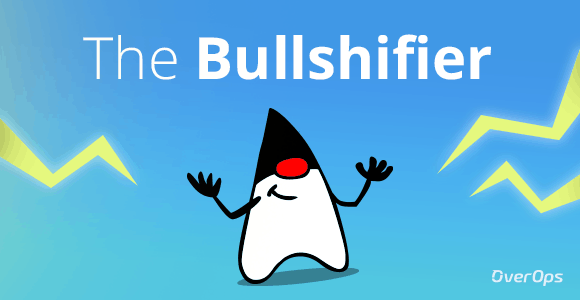An open source project by OverOps.
Visit the site to download a sample result or read more on the blog
- Groovy installed
- Gradle installed
- Java installed
- Download, unzip, and you’re ready to go
./gradlew run(default parameters, generates one jar with 10 classes)cd output && gradle fatJarto build the generated projectjava -cp output/build/libs/tester.jar helpers.Mainto run it
Or, you can simply run ./scripts/small.sh, or ./scripts/big.sh, with preconfigured run settings.
-Poutput-directory(relative path to output directory)-Poutput-classes(number of classes to generate)-Psubprojects(number of jars to generate)
Keep in mind that generating over 500 classes will take quite some time. Our biggest run had 20,000 classes, but it's better to keep this under 5,000.
gradle build(get a WAR file)- Go to
bin - A shell script is created per project, root will run them all
There are some additional options that give you fine grained control over the generated code, but might mess it up, use at your own risk:
- Low level config:
src/main/groovy/generator/Config.groovy - Higher level config is available in the output folder. There are more options to add logging, and fine tune the behavior of the application but it’s experimental at the moment.
If you’d like to learn more, feel free to reach out for a deeper walkthrough (hello@overops.com). Default settings are no logs, and an exception on every 10th frame in the call stack.
In simple cases the following command will allow for local execution of the image. If running backend and collector also in docker see "advance" networking section.
docker run -d --rm -e TAKIPI_COLLECTOR_HOST=<collector_hostname> -e TAKIPI_COLLECTOR_PORT=6060 -e TAKIPI_APPLICATION_NAME=java-bullshifier -e TAKIPI_DEPLOYMENT_NAME=deployment1 -e TAKIPI_SERVER_NAME=DEV -e COLOR=white/yellow/red/black overops-java-bullshifier:latestNote: Depending if you built or pulled the image your Image name may vary!
If running multiple components in separate docker images (i.e. Backend and collector), it is recommend running with a docker network to allow for communications:
If not already created, create a docker network and start the image on the network:
docker network create --driver bridge overops
docker run -d --rm --network overops -e TAKIPI_COLLECTOR_HOST=<collector_hostname> -e TAKIPI_COLLECTOR_PORT=6060 -e TAKIPI_APPLICATION_NAME=java-bullshifier -e TAKIPI_DEPLOYMENT_NAME=deployment1 -e TAKIPI_SERVER_NAME=DEV -e COLOR=<white/yellow/red/black> overops-java-bullshifier:latestNote: This assumes you have a collector running in docker with --network overops --name overops-collector
The following table lists the configurable ENVS of the Java Bullshifier using -e:
| Parameter | Description | Default |
|---|---|---|
TAKIPI_COLLECTOR_HOST |
Collector hostname or K8s Service Name | collector |
TAKIPI_COLLECTOR_PORT |
Collector port | 6060 |
COLOR |
The plan of the Bulshifier - affect on how intense will be the load on the application - (Options: white/yellow/red/black) . | white |
RUNNING_DURATION_HOURS |
The number of hours java-bullshifier app should be running | 0 |
RUNNING_DURATION_MINUTES |
The number of minutes java-bullshifier app should be running | 5 |
INERVAL_MILLIS |
Interval between events (millis) | 300 |
GEN_SEED |
(Optional) Numerical value used to seed random functions when generating Java Application | |
APP_SEED |
(Optional) Numerical value used to seed random functions when running the generated application | |
TAKIPI_SERVER_NAME |
Override the server name used by the agent | hostname joined with index |
TAKIPI_APPLICATION_NAME |
Override the application name used by the agent | tester or what is provided during gradle run with the name option |
TAKIPI_DEPLOYMENT_NAME |
Override the deployment name used by the agent | hostname joined with app name and deployment seed/process count |
TAKIPI_ENV_ID |
Set the environment name used by the agent | value of TAKIPI_SERVER_NAME |
